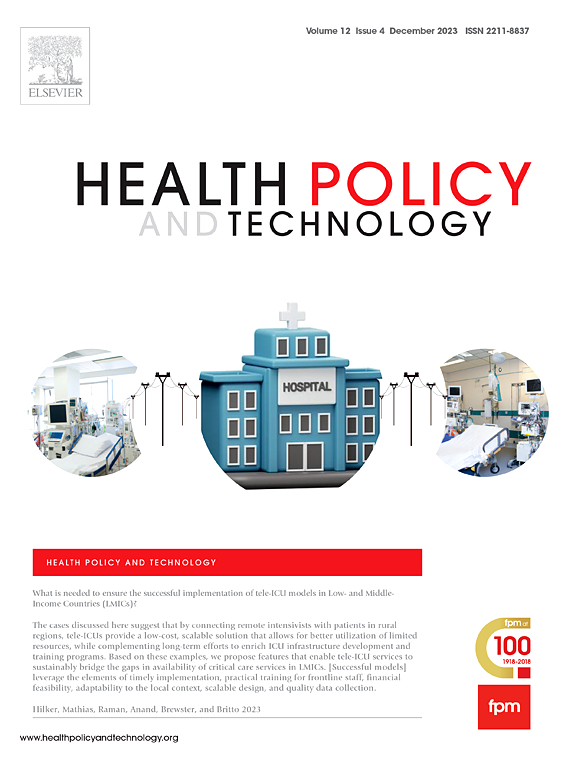伊朗卫生技术评估实施路线图
IF 3.4
3区 医学
Q1 HEALTH POLICY & SERVICES
引用次数: 0
摘要
与高收入国家相比,卫生技术评估(HTA)在伊朗是一项相对较新的举措,但与其他中等收入国家的发展相一致。本研究旨在通过确定当前HTA框架与其期望的未来状态之间的差距,设计未来十年在伊朗实施HTA的路线图。方法本研究利用HTA实施记分卡评估HTA在能力建设、资金、组织结构、范围、决策标准、质量和透明度、本地数据使用和国际合作等八个关键领域的现状和未来目标。通过方便抽样选择35名利益相关者参加一对一访谈。这些利益攸关方代表了卫生部、经济委员会、医科大学和教学医院等组织,确保了对卫生保健和制药决策的不同观点。结果88.6%的受访者来自公共部门。关于HTA教育,28.6%的人认为基于项目的培训很普遍,而42.9%的人认为存在永久性的研究生课程。大多数人(94.1%)预计在未来十年内,HTA教育体系将更加结构化。公共资金被认为是HTA报告评估的主要来源(68.6%),尽管83%的人报告说HTA目前在决策过程中没有正式的作用。本研究强调了为伊朗制定HTA路线图的优先事项和挑战,包括政治、金融和基础设施障碍。研究结果强调了能力建设、加强数据利用和国际合作以实现HTA长期目标的必要性。进一步的研究对于制定在伊朗可持续实施HTA的战略至关重要。本文章由计算机程序翻译,如有差异,请以英文原文为准。
Implementation roadmap of health technology assessment in Iran
Background
Health Technology Assessment (HTA) is a relatively new initiative in Iran, compared to high-income countries, but aligns with developments in other middle-income countries. This study aims to design a roadmap for HTA implementation in Iran over the next decade by identifying gaps between the current HTA framework and its desired future state.
Methods
The study utilized an HTA implementation scorecard to assess the current state and future goals of HTA across eight key areas: capacity building, funding, organizational structure, scope, decision-making criteria, quality and transparency, use of local data, and international collaboration. 35 stakeholders, selected via convenience sampling, participated in one-on-one interviews. These stakeholders represented organizations such as the Ministry of Health, economic committees, medical universities, and teaching hospitals, ensuring diverse perspectives on HTA and pharmaceutical decision-making.
Results
Of the participants, 88.6 % were from the public sector. Regarding HTA education, 28.6 % identified project-based training as prevalent, while 42.9 % noted the existence of permanent graduate programs. A majority (94.1 %) anticipate a more structured HTA education system within the next decade. Public funding was cited as the primary source for HTA report appraisals (68.6 %), though 83 % reported that HTA currently has no formal role in decision-making processes.
Conclusion
This study highlights the priorities and challenges in establishing an HTA roadmap for Iran, including political, financial, and infrastructural barriers. The findings emphasize the need for capacity building, enhanced data utilization, and international collaboration to achieve long-term HTA goals. Further research is essential to develop strategies for sustainable HTA implementation in Iran.
求助全文
通过发布文献求助,成功后即可免费获取论文全文。
去求助
来源期刊

Health Policy and Technology
Medicine-Health Policy
CiteScore
9.20
自引率
3.30%
发文量
78
审稿时长
88 days
期刊介绍:
Health Policy and Technology (HPT), is the official journal of the Fellowship of Postgraduate Medicine (FPM), a cross-disciplinary journal, which focuses on past, present and future health policy and the role of technology in clinical and non-clinical national and international health environments.
HPT provides a further excellent way for the FPM to continue to make important national and international contributions to development of policy and practice within medicine and related disciplines. The aim of HPT is to publish relevant, timely and accessible articles and commentaries to support policy-makers, health professionals, health technology providers, patient groups and academia interested in health policy and technology.
Topics covered by HPT will include:
- Health technology, including drug discovery, diagnostics, medicines, devices, therapeutic delivery and eHealth systems
- Cross-national comparisons on health policy using evidence-based approaches
- National studies on health policy to determine the outcomes of technology-driven initiatives
- Cross-border eHealth including health tourism
- The digital divide in mobility, access and affordability of healthcare
- Health technology assessment (HTA) methods and tools for evaluating the effectiveness of clinical and non-clinical health technologies
- Health and eHealth indicators and benchmarks (measure/metrics) for understanding the adoption and diffusion of health technologies
- Health and eHealth models and frameworks to support policy-makers and other stakeholders in decision-making
- Stakeholder engagement with health technologies (clinical and patient/citizen buy-in)
- Regulation and health economics
 求助内容:
求助内容: 应助结果提醒方式:
应助结果提醒方式:


